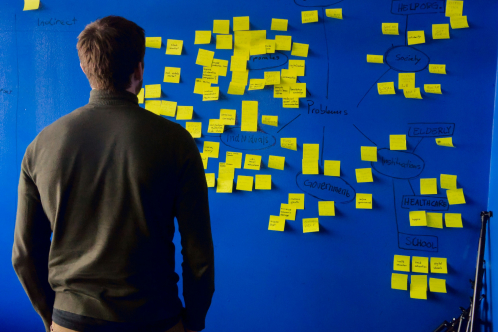Recently, one of our clients asked us how to ensure that their prototype launch was successful. In our climate of constant innovation, technologies are becoming obsolete at a never-before seen rate.
There are, of course, no guarantees — but using a “Minimum Viable Product” approach is the best place to start.
In the following post, I will break down the steps to create an MVP, using the example of the worldwide gaming phenomenon, “Pokémon GO.”
Minimum Viable Product
Some of you are probably asking, what exactly is “minimum viable product”? (those of you who already know, feel free to skip ahead).
MVP is the minimum feature set the market will pay for. Your product should have enough unique features to set it apart from the competition, but not so many as to waste unnecessary (and expensive) research and development time. Naturally, this can be a difficult balance to strike.
NOTE: MVPs are different from functional prototypes. To learn more, read this article instead.
1. Identify Your Target Market
The first step in developing any successful product, is to research your target market. Once you have a handle on your target market, you can begin to tailor your product towards it. Below is a chart outlining Pokémon GO’s target demographic:
| Age | Millennials (age 18-30) |
| Budget | Low (many are students / entry level workers) |
| Needs | Entertainment |
| Gender | Mixed |
| Interests | Gaming — many are still nostalgic about the original Pokémon games (1996-1999) |
| Geographic Location | All over the world |
| Education Level | Mixed |
| Marital Status | Mostly unmarried |
| Ethnic Group | Mixed |
| Lifestyle | Active |
Pokémon GO was aimed at millennials with smartphones. The game appealed to their childhoods, when they watched the T.V. show, collected the cards, and played the Gameboy games. The augmented reality feature allowed them to “travel across the land, searching far and wide” for Pokémon, thus fulfilling their childhood fantasies. Additionally, the game featured the original 150 playable characters that millennials grew up with.
2. Assess Your Target Market’s Needs vs. Wants
It is important to distinguish what your target audience needs in your product, versus what it wants in your product:
“Needs” are the fundamental features your app can’t exist without. For instance, Pokémon GO would not have worked without its augmented reality feature. Without this crucial element, users would not be able to travel around and search for the playable monsters. This was the feature that set Pokémon GO apart from all other games.
Pokémon GO also fulfills a deeper, subtler psychological need many consumers don’t even know they have. Technology has the ability to stimulate the reward centers of the brain — completing a small task, like capturing a Pokémon sends dopamine rushing through the limbic system, making you happy. This, combined with the endorphins your body receives from physical activity, make for psychologically addictive gameplay.
“Wants” are less important features, that are not essential to the core function of the app. For instance, many players have expressed a “want” to be able to battle their Pokémon against any player in the world. Though this is a big opportunity, Pokémon GO succeeded without it.
Another want consumers have frequently expressed is the ability to trade Pokémon. Many kids grew up trading Pokémon cards, and feel that this is a crucial element, which Pokémon GO lacks. The game loses a sense of community when people can’t exchange in mutually beneficial Pokémon trades, helping each other “catch ‘em all.”
3. Test Your Prototype
The most helpful way to separate needs from wants, is to engage in user testing. Obviously, as a developer, you’re too close to the product to give honest, unbiased feedback. To receive the best results, you need to have your product tested by a random sample from your target market.
There are three main types of testing:
- Generative Research — subjects help you generate conceptual ideas for your product, at the beginning of your prototyping period
- Formative Research — subjects help you guide your process, in the middle of your prototyping period
- Summative Research — subjects help you evaluate your finished prototype, at the end of the period
For instance, in generative research, millennials may have said they wanted a game that allowed them to catch Pokémon in the real world. In formative research, they may have directed Nintendo toward the reality augmentation interface that had the easiest usability. And, in summative research, they may have gone out to catch Pokémon, ultimately weighing in on whether or not they would play the game upon its release.
Your budget and stage in the process will determine what type(s) of testing you ultimately engage in. Keep in mind, the more testing you do, the better your product will translate to the real world.
After proofing your product through user testing, to ensure it fills your market’s needs, the next step is to put your product out. With the competition working to develop similar products, timing is essential. You should send your app to the market as soon as possible– it’s crucial you don’t waste time and money on superfluous features that aren’t crucial to your user base.
Pokémon GO Executed its July 6th 2016 release brilliantly, generating over $35 million during its first two weeks. It beat competitors to the marketplace, establishing itself as the first augmented reality mobile game.
However, being first to market comes with a caveat — as entrepreneur and Stanford Professor Benny Xian said, “It’s not about being first to market. It’s about being the first to get it right.” You should not rush out to customers — by this point, you should have conducted adequate user research to determine your product will be a success.
Furthermore, you need to make sure your timing makes sense for your target market. The summer was the perfect time for Nintendo to roll out this new app — its target demographic was on summer vacation, and had plenty of time to roam the neighborhoods searching for Pokémon.
5. Maintain Your User Base Through Updates
Your product’s journey does not end with your release. Once you have established a solid user base, you need to continue to develop your product, catering to their additional wants. It is important to keep in touch with your customers throughout their experience, so you can learn how to improve it. There are several ways to accomplish this:
- Conduct user surveys (reward incentives yield higher participation)
- Interact with customers on social media
- Create a forum / online community on your site
- Provide proactive live chat support
- Provide detailed feedback forms on your site
- Measure your customer service performance
- Use polls
- Maintain a blog
- Send out monthly newsletters
- Put on events
- Give special offers to loyal customers (especially this guy)
This is one area in which Pokémon GO has failed. An unprecedented 100 million users had downloaded the app by the beginning of August — but, by the end of the month, usership declined to under 22 million. This is a far worse retention rate than that of other popular mobile games.
Nintendo did not update or improve on its MVP within the first three months of the release, leading many users to complain about the game’s lack of depth. Players are able to capture and level up Pokémon, but after this, there isn’t much to do. Players can only battle in gyms, and oftentimes, the opponents are too challenging for them to have any modicum of success.
Conclusion
Nintendo’s Pokémon GO was incredibly successful as an MVP, offering a unique, compact feature set to its millennial target market. The game had enough appeal to receive a few weeks of playing time from over 100 million people. However, Nintendo failed to expand Pokémon GO to a full-blown gaming experience. Had they kept in better touch with customers, they would have realized their gameplay would eventually plateau. Thus, without retooling the game to satisfy any of the users’ additional “wants,” the Pokémon GO’s popularity has faded at an alarming rate.
WANT TO LEARN MORE ABOUT CREATING FUNCTIONAL PROTOTYPES? Read our next article.





